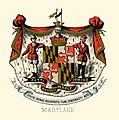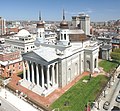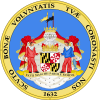Portal:Maryland
|
Maryland Portal
|
Baltimore Task Force
|
Frederick Task Force
|
Montgomery Task Force
|
WikiProject Maryland
|
|
Main page
|
Discussion
|
Introduction Maryland (US: /ˈmɛrɪlənd/ MERR-il-ənd) is a state in the Mid-Atlantic region of the United States. The state borders Virginia to its south, West Virginia to its west, Pennsylvania to its north, Delaware to its east, the Atlantic Ocean, and the national capital of Washington, D.C. With a total area of 12,407 square miles (32,130 km2), Maryland is the ninth-smallest state by land area, and its population of 6,177,224 ranks it the 18th-most populous state and the fifth-most densely populated. Maryland's capital is Annapolis, and the most populous city is Baltimore. Occasional nicknames include Old Line State, the Free State, and the Chesapeake Bay State. It is named after Henrietta Maria, the French-born queen of England, Scotland, and Ireland during the 17th century. Maryland's coastline was first explored by Europeans in the 16th century. Prior to that, it was inhabited by several Native American tribes, mostly the Algonquian peoples and, to a lesser degree, Iroquoians and Siouans. As one of the original Thirteen Colonies, Maryland was founded by George Calvert, 1st Baron Baltimore, a Catholic convert who sought to provide a religious haven for Catholics persecuted in England. In 1632, Charles I of England granted Lord Baltimore a colonial charter, naming the colony after his wife, Henrietta Maria. Unlike the Pilgrims and Puritans, Lord Baltimore envisioned a colony where people of different religious sects would coexist under the principle of toleration. In 1649, the Maryland General Assembly passed an Act Concerning Religion, which enshrined this principle by penalizing anyone who "reproached" a fellow Marylander based on religious affiliation. Nevertheless, religious strife was common in the early years, and Catholics remained a minority, albeit in greater numbers than in any other English colony. Maryland's early settlements and population centers clustered around rivers and other waterways that empty into the Chesapeake Bay. Its economy was heavily plantation-based and centered mostly on the cultivation of tobacco. Demand for cheap labor from Maryland colonists led to the importation of numerous indentured servants and enslaved Africans. In 1760, Maryland's current boundaries took form following the settlement of a long-running border dispute with Pennsylvania. Maryland was an active participant in the events leading up to the American Revolution, and by 1776, its delegates signed the Declaration of Independence. Many of its citizens subsequently played key political and military roles in the war. Although then a slave state, Maryland remained in the Union during the American Civil War, its strategic location giving it a significant role in the conflict. After the Civil War, Maryland took part in the Industrial Revolution, driven by its seaports, railroad networks, and mass immigration from Europe. Since the 1940s, the state's population has grown rapidly, to approximately six million residents, and it is among the most densely populated U.S. states. , Maryland had the highest median household income of any state, owing in large part to its proximity to Washington, D.C., and a highly diversified economy spanning manufacturing, retail services, public administration, real estate, higher education, information technology, defense contracting, health care, and biotechnology. Maryland is one of the most multicultural states in the country; it is one of the six states where non-Whites compose a majority of the population, with the fifth-highest percentage of African Americans, and high numbers of residents born in Africa, Asia, Central America, and the Caribbean. The state's central role in U.S. history is reflected by its hosting of some of the highest numbers of historic landmarks per capita. (Full article...) This is a Featured article, which represents some of the best content on English Wikipedia..
 William McSherry SJ (July 19, 1799 – December 18, 1839) was an American Catholic priest and Jesuit who became the president of Georgetown College and a Jesuit provincial superior. The son of Irish immigrants, McSherry was educated at Georgetown College, where he entered the Society of Jesus. As one of the first Americans to complete the traditional Jesuit course of training, he was sent to Rome to be educated for the priesthood. There, he made several discoveries of significant, forgotten holdings in the Jesuit archives, which improved historians' knowledge of the early European settling of Maryland and of the language of Indian tribes there. McSherry became the first provincial superior of the Jesuits' Maryland Province from 1833 to 1837, and laid the groundwork for the sale of the province's slaves in 1838. He then briefly became the president of Georgetown College in 1837, and was simultaneously made provincial superior for a second time in 1839, despite suffering illness to which he would succumb several months later. (Full article...)General imagesIn the news
On this day...The Maryland portal currently doesn't have any anniversaries listed for June 8. You can help by viewing the page source of an existing entry at /On this day to see how the entries should be formatted, then adding the missing entry. This is a Good article, an article that meets a core set of high editorial standards.
Same-sex marriage has been legally recognized in Maryland since January 1, 2013. In 2012, the state's Democratic representatives, led by Governor Martin O'Malley, began a campaign for its legalization. After much debate, a law permitting same-sex marriage was passed by the General Assembly (Maryland's bicameral legislature, composed of the Senate and the House of Delegates) in February 2012 and signed on March 1, 2012. The law took effect on January 1, 2013 after 52.4% of voters approved a statewide referendum held on November 6, 2012. The vote was hailed as a watershed moment by gay rights activists and marked the first time marriage rights in the United States had been extended to same-sex couples by popular vote. Maryland was the ninth U.S. state to legalize same-sex marriage.
Selected article -St. John's College is a private liberal arts college with campuses in Annapolis, Maryland, and Santa Fe, New Mexico. As the successor institution of King William's School, a preparatory school founded in 1696, St. John's is one of the oldest institutions of higher learning in the United States; the current institution received a collegiate charter in 1784. In 1937, St. John's adopted a Great Books curriculum based on discussion of works from the Western canon of philosophical, religious, historical, mathematical, scientific, and literary works. The college grants a single bachelor's degree in liberal arts. The awarded degree is equivalent to a double major in philosophy and the history of mathematics and science, and a double minor in classical studies and comparative literature. Two master's degrees are available through the college's graduate institute: one in liberal arts, which is a modified version of the undergraduate curriculum, and one in Eastern Classics, which applies a Great Books curriculum to a list of classic works from India, China, and Japan. (Full article...)Did you know?

SubcategoriesSelect [+] to view subcategories
TopicsRelated portalsAssociated WikimediaThe following Wikimedia Foundation sister projects provide more on this subject:
Discover Wikipedia using portals |






















































